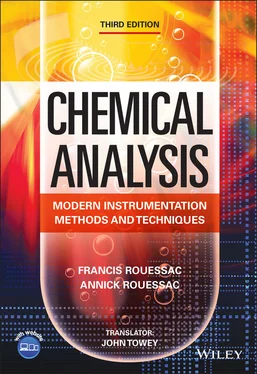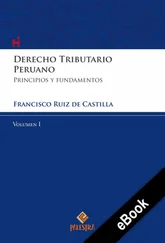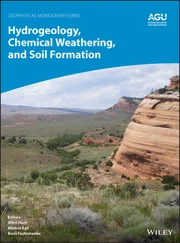Any study of chemical analysis involves addressing varied fields of knowledge. To reach the desired goal, it calls on many concepts, including some that range very far away from chemistry, in the usual sense of the word. It is a multidisciplinary science whose repercussions are felt in all experimental sciences.
In chemical analysis, it is common to distinguish between two categories of methods. Firstly, there are chemical methods, based on a specific reaction of the analyte (the compound being assayed) with reagents, and then there are physical techniques, which make use of the physico‐chemical properties of analytes.
This second category of methods, now in the forefront, has replaced the traditional ‘wet’ methods, which are very limited in their performance but which were at the origin of the field of analytical chemistry . Most of this book is therefore dedicated to modern techniques, which have been greatly developed over these past few decades with the rise of miniaturized sensors, digitization, and computing power. These improvements have thus enabled the use of very efficient mathematical tools and less bulky equipment. As an example, we can compare the imposing Raman spectrophotometers from the 1960s with the portable Raman spectrometers that are now used for quality control in numerous fields.
And so was born instrumental analysis with its incredible arsenal of processes and devices which we now often find installed outside of traditional analytical laboratories.
The evolution of technologies has led to the creation of very efficient instruments that open up new possibilities. This is especially true with the introduction of coupled methods, nondestructive testing, and the concept of speciation (distinction between the various structures in which an element may be present in the sample). These methods use small samples that require little or no preparation prior to measurement. Current analytical trends also include an increase in miniaturized, portable instruments, as well as specific or automatic analysers.
In general, the basic principle consists in measuring a physical value, followed by establishing a simple relationship between this measurement – the device’s response – and the composition of the analyte in the test sample. The search for this relationship often consists in a mathematical linearization between the device’s response and the analyte concentration. This relationship may be simple and direct (the response is proportional to concentration), or it may be more complex.
Whatever the tool used to establish the relationship between the signal and the concentration, we also have to determine the limits of quantification. Below that limit, any attempt at quantification is bound to fail, while above it the relationship no longer applies.
To conduct these studies, analysts must not only be trained in the various techniques, but they must also know the basic concepts of chemistry, particularly since a compound can often be assayed by various methods. Choosing a good method, and if possible the best method, requires knowing many parameters. Therefore, when a new analytical objective has been defined, the problem must be addressed methodically. We must first choose the right method : spectroscopic, electrochemical, separation, etc. Then the choice of technique is made, followed by the choice of process in terms of sampling and prior treatment of the sample. Finally, a protocol , the recipe so to speak, is established. In general, this is a process governed by established national or international standards, which leads to the chosen operating procedure. This approach focuses on standardizing all the steps: from sample preparation all the way to conducting measurements. Finally, results must be established according to existing standards. Additionally, the raw analytical data conserved as computer files cannot be changed. This entire approach is the subject of official texts known as Good Laboratory Practice (GLP).
To recommend the best method in order to resolve an analytical problem, there is a science called chemometrics . Its purpose is to help the analyst, as a function of specific requirements and aims: minimum sampling plan, appropriate methodology, data processing and interpretation of results. Thanks to the use of IT tools, it seeks to provide a correct answer by exploiting the results with statistical methods in order to reduce the number of tests for long or costly analyses.
In this way, users may acquire devices that meet the standard of precision and quality necessary to acquire certification or to have a laboratory officially recognized for the quality of its results. These accreditation procedures are now imposed by many control organizations around the world.
Analytical chemistry is therefore essential in many fields other than the traditional ones of chemistry or chemical engineering. It can be found in fields as varied as medicine, food, biochemistry, the environment (pollution), safety (explosives, drugs and chemicals), and art. Now more widely used in human activities than ever, analytical chemistry can be of benefit to us all.
Chapter 1 General Aspects of Chromatography
INTRODUCTION
Chromatography, the process by which the components of a mixture can be separated, has become one of the primary analytical methods for the identification and quantification of compounds. The basic principle is founded on the concentration equilibrium of the components of interest between two immiscible phases. One is called the stationary phase, because it is immobilized within a column or fixed upon a support, while the second, called the mobile phase, is forced through the first. The phases are chosen such that the components of the sample have differing solubilities in each phase. The differential migration of compounds leads to their separation. This hydrodynamic process, which has been constantly evolving since its discovery, is an analytical method that no laboratory involved in molecular analysis can ignore, as its applications are so numerous.
Reviewthe principle of chromatography
Distinguishbetween separation and analysis by chromatography
Explainthe protocol of a chromatographic analysis
Usea chromatogram and model its signals
Describethe various retention parameters
Discussthe hydrodynamic aspects of a separation
Defineparameters influencing the efficiency of a separation
Classifythe various chromatography techniques
Describethe steps of an assay using chromatography
1.1 GENERAL CONCEPTS OF ANALYTICAL CHROMATOGRAPHY
Chromatography is a physico‐chemical method of separation of components within mixtures, liquid or gaseous, in the same vein as distillation, crystallization or fractionated extraction. The applications of this process are therefore potentially numerous, since many heterogeneous mixtures, or those in solid form, can be dissolved by a suitable solvent (which becomes, of course, a supplementary component of the mixture).
A basic chromatographic process may be described as ( Figure 1.1):
1 A vertical, hollow glass tube (the column) is filled with a suitable finely powdered solid, the stationary phase.
2 At the top of this column is placed a small volume of the sample to be separated into individual components.
3 The sample is then forced through the column from inlet to outlet by continuous addition of the mobile phase, carrying the various constituents of the sample along with it. If the components migrate at different velocities, they will become separated from each other and can be recovered, each in solution with the mobile phase.
Читать дальше




![Евгений Матерёв - Музеи… или вдохновляющая музыка The Chemical Brothers [litres самиздат]](/books/437288/evgenij-materev-muzei-ili-vdohnovlyayuchaya-muzyka-th-thumb.webp)







